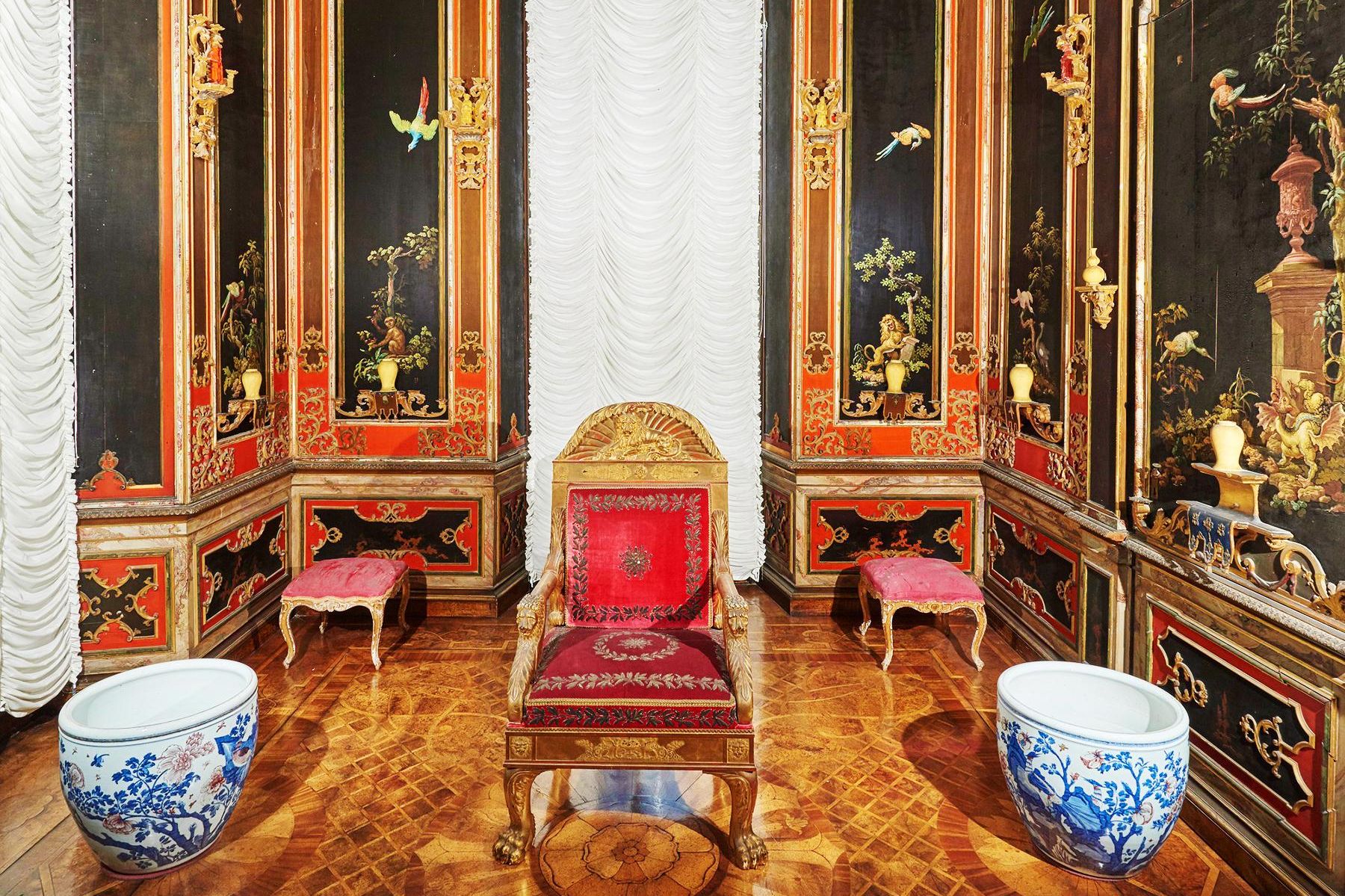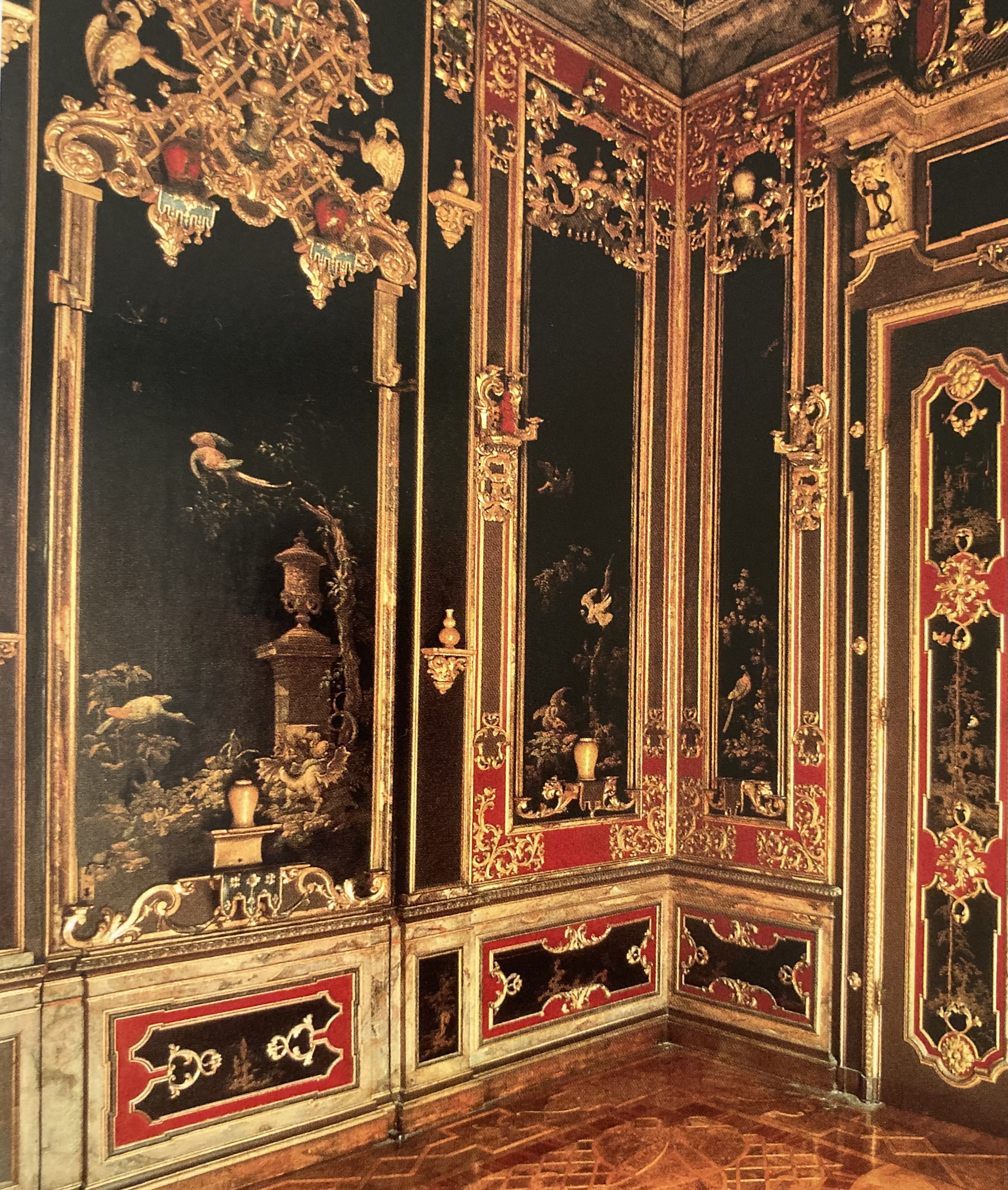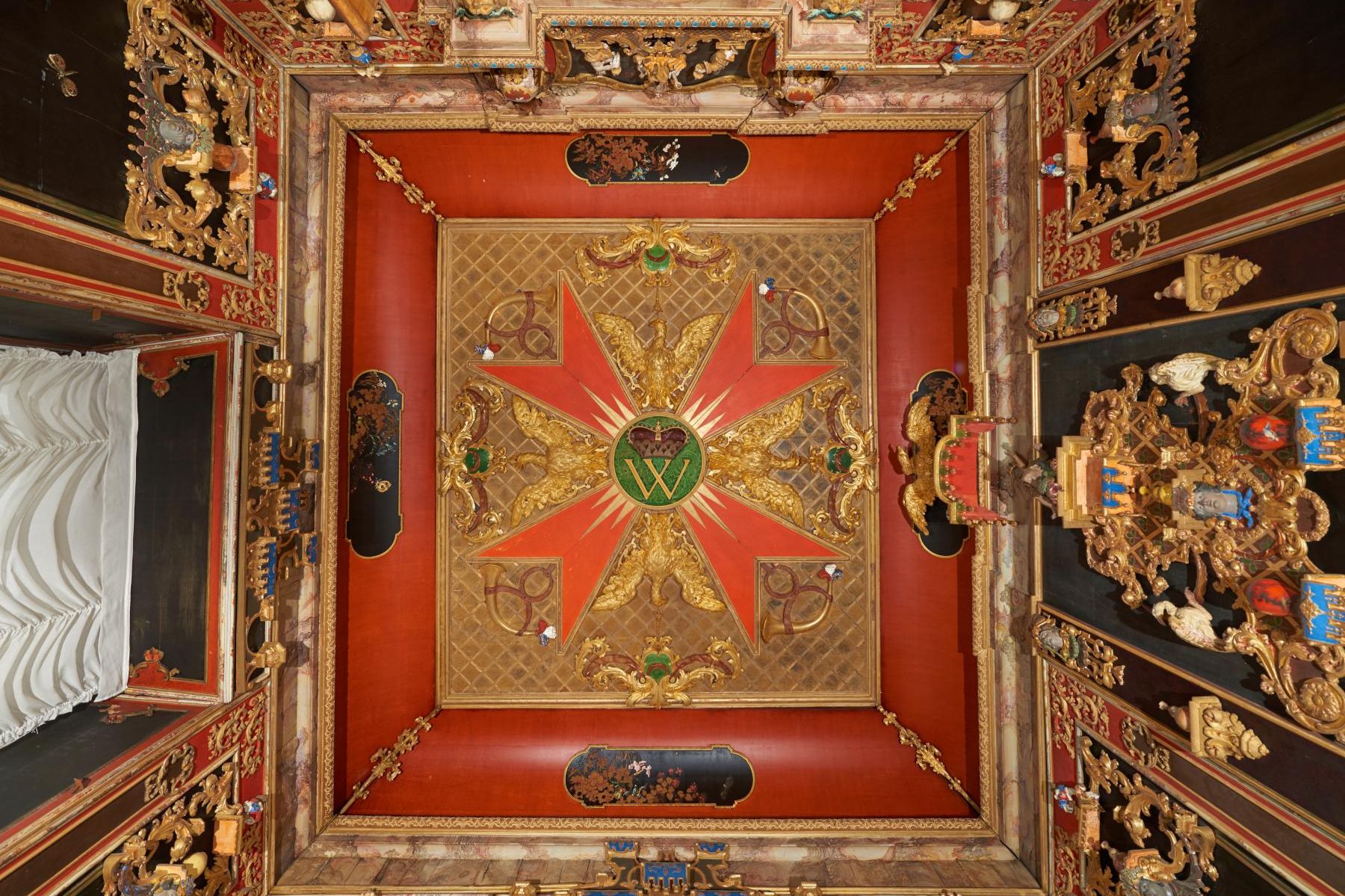An impressive writing cabinet standing upon a richly executed gilt wooden console. The four legs of the console are shaped like Satyrs and terminate in four single goat’s feet. These are interconnected by four beams whose central meeting point incorporates ornamented acanthus leaves and a bracket. The console’s skirt is decorated with a central mascaron ornament representing Ariadne, flanked by elegant acanthus leaves on a trelliswork base. This console bears the red and black lacquered cabinet, which is decorated with faux marbling at the top and bottom as well as around the red planes. The cabinet incorporates nine visible drawers, which are decorated with black lacquered panels in carved frames of gilt wood. At the cabinet’s centre is a lockable door bearing a large black lacquered panel. This panel is the richest in decoration, depicting a roaring dragon in a landscape. Beneath this door is the lockable writing board, which extends across the entire width of the cabinet, behind which are four smaller black lacquered drawers. Removing the bottom drawers reveals the mechanism that allows the simultaneous locking of all drawers above. The sides of the cabinet are embellished with a single large lacquerwork panel decorated with birds of paradise.
The execution, construction and ornamentation of this writing cabinet is a perfect match with the woodwork in a room in Ludwigsburg Palace. The similarities between this small room within the palace, known as the Indianische Lackkabinett, and the present writing cabinet are so extensive that they were indubitably created by the same hand. As such, we know who created this cabinet and when, as there exists a great amount of information about the Indianische Lackkabinett and its construction.
The Indianische Lackkabinett in Ludwigsburg Palace is a small room that was built between 1714 and 1722 by designer and builder Johan Jakob Saenger, with assistance from court sculptor Sebastian Zimmermann (1655-1728).

Duke Eberhard Ludwig von Wurttemberg had a hunting lodge built in 1704, but soon wished to further expand it in order to accommodate his ever-growing court. Work therefore commenced on the construction of a Gallery with a pavilion attached to the western wing. Between 1714 and 1722, a small room was built in the southwestern corner of this new western pavilion that has survived in its original condition to this day.
Known as the Indianische Lackkabinett, the room has a floor area of 430 x 380 cm, with the ceiling at 540 cm, and its walls are entirely finished with black lacquered panels depicting landscapes and fantastic creatures. The panels are contained in ornamental gilt wood frames, which in turn are placed within red lacquered panels. Around these are faux marbling frames at all levels of the panelling.

The wish to build a lacquerwork cabinet was quite fashionable in the late seventeenth century. This started in Holland and England, where the walls of such rooms were covered with genuine or imitation lacquer. At this stage, the lacquer itself was the main object, and any further decoration was very sober. A famous example of a lacquerwork cabinet of this kind is the one that was built for the stadtholder’s court in Leeuwarden before 1695, now on display at Rijksmuseum in Amsterdam. Here, original Chinese coromandel lacquer folding screens were sawn into sections for use as wall panelling. The room was used as a tea parlour and furnished with exotic furniture and china.
Lacquered rooms were also built for palaces in Berlin, Bayreuth, Munich and Dresden. The major difference between these and the room in Ludwigsburg is that the panelling in all the other cabinets incorporated Eastern lacquered panels, while the Ludwigsburg Kabinett is a thoroughly contemporary German product.
The technique of imitating Chinese or Japanese lacquerwork examples was practiced throughout Europe. In Holland, masters such as Willem Kick were already imitating lacquer in the early seventeenth century. In Germany, the Berlin-based Dagly built glossy lacquered furniture around 1700, while in Dresden, China fashion reached its peak between 1710 and 1720, resulting in the construction of exceptional lacquered furniture.
The court of Ludwigsburg was well aware of these fashion developments: Duke Eberhard Ludwig had probably seen lacquered rooms in person on his travels to England and Holland around the year 1700. He had close ties to the court of Vienna and owned property in the city, and it is therefore quite possible that he seen such rooms there as well.
The plan for the Indianische Lackkabinett was first raised on 3 February 1714, when the Indianische Kammermaler Johann Adalbert Kratochwyl, who had spent the previous two years in Vienna, presented a plan for a Lackkabinett with paintings on canvas. The head of construction, Nette, rejected the plan, because he found the price of 9,000 florins to be excessively expensive.
In Nette’s opinion, there were other artists to be found in Berlin and elsewhere who could do the job just as well. And he was right: later that same year, Johann Jakob Saenger of Neurenberg, born in Sachsen Gotha, offered his services,
advertising himself as “dauerhafter Lacq- und Kunstminiatur Mahlerey Arbeit.” Saenger had learned a great deal on his travels in Italy and other countries, and had mastered a fire-proof lacquer technique that could be applied to tables, coffee trays, toiletry sets, cabinets and writing tables. Saenger also claimed to have built a Kabinett for the palace in Rastatt. Although this was probably not entirely true, it did help him obtain the position.
He offered to build “a gallant, lacquered chamber with agate and marble-like paintings and fills in a Chinese black manner decorated with Indian gold and other exotic finds.”
Saenger had only just begun work when chief master builder Nette suddenly passed away. However, the duke seemed very pleased with Saenger and immediately involved the artisan more extensively in the palace’s construction. The books show that Sebastian Zimmermann, the court sculptor, was asked to create a variety of sculptures. These likely concern the frames in which the lacquered panels were placed.
Zimmermann had been court sculptor in Ludwigsburg since 1704. He had travelled to Italy for his studies around 1700, and this experience formed the foundation for his status as a sculptor. However, the master builder and the duke were rarely satisfied with his works in stone, which is probably why he was tasked with a variety of other assignments for mirror frames, painting frames and decorative tables. Nevertheless, Zimmermann remained involved in the construction of the palace until his death.
He was paid 1000 florins for his work on the Lackkabinett. It is likely that this also included the supporting frame and the panelling for the writing cabinet. Upon completion of the cabinet in 1722, the immensely pleased duke paid Saenger two gold medals, together worth 300 florins and a bonus of 400 florins, putting his total payment at 6400 florins. Nevertheless, Saenger returned to Ansbach grumbling, because – as hearsay had it – the eight years he had spent in Duke Wurttemberg’s service had been filled with betrayals, hatred and envy, so much so that he felt compelled to leave. However, there was little for him to do in Ansbach, or so it seems: he soon moved on to an unknown destination. As a result, there exist no further known works by the hand of this industrious artisan.
This writing cabinet is one of the rare few items of furniture of which we can state with certainty that they once formed part of the furnishings of Ludwigsburg Palace. All of the palace’s original furniture was sold off or lost over the centuries. The reappearance of this cabinet gives us a great deal of new information about the palace’s interior. An estate inventory from 1721 (Hauptstaatsarchiv Stuttgart A21 bd 9) reveals that the building was only sparsely furnished. Although it was richly decorated with ceiling paintings, stucco ornamentation and tapestries, the amount of furniture was relatively small. Each of the rooms only held small numbers of chairs, gueridons and tables. The important rooms were furnished with gilt and carved consoles described as Bildhauerarbeiten (sculptural works), as well as gilt-framed mirrors. The fact that the palace contained almost no luxury furniture is remarkable, as is the fact that the furnishings often did not form a cohesive whole. Instead, highly diverse items of furniture were grouped together, with chairs, sofas and so forth often upholstered in entirely different materials and colours. Apparently this did not bother anybody at the time.
There were only very few writing tables and cabinets. One Indian writing table with red and white lacquer stood in the Grävenitz’s bedroom. The inventory also lists three small lacquered cabinets on table frames: one blue, one red and one black. The inventory’s description of the present writing cabinet notes that it was located in the Furstenbau on the middle floor, in the Schreiner Cabinet in the Marmoeriersaal: “1 laquirt und eingelegter schreib tisch in … mit 9 schubladen.”
In view of the Lackkabinett’s identical decoration scheme and the accurate description of this cabinet in the estate inventory, there can be no doubt that this lacquered writing cabinet is the very cabinet that stood in Ludwigsburg Palace in 1721. The similarities regarding the decorative elements are numerous: the dragon and pillar that adorn the writing cabinet’s central panel are exactly replicated in the main panel of the Lackkabinett, for example. The colour schemes of the faux marbling decorations are identical, as are their patterns and placement. The concave moulding in the room is repeated in the upper edge of the writing cabinet, where it performs a similar stylistic function. The Lackkabinett’s repetitive scheme of black lacquered panels with gilt carved frames set within red lacquer panels is another perfect match with the writing cabinet’s structure.
Although the estate inventory does not identify the maker of the writing cabinet, we can conclude that the cabinet and the Lackkabinett display such extensive similarities that they cannot be regarded as separate. Both must therefore have been constructed by Johan Jakob Saenger and Sebastian Zimmermann between 1714 and 1722.
Literature:
Werner Fleischhauer, Barock im Herzogtum Württemberg, Stuttgart 1958, pp. 137-163, 201-203, 226
Werner Fleischhauer, ‚Das indianische Lack- und das türkische Boiserienkabinett in Ludwigsburg‘, Neue beiträge zur Archäologie und Kunstgeschichte Schwabens (1952), pp. 187-195.
Monika Kopplin, European Lacquer, München 2010, p, 200,201
Heinrich Kreisel, Georg Himmelheber, Die Kunst des Deutschen Möbels, Munich 1973, 3 volumes, vol. 2 fig. 304, p.118,119
Daniel Schulz, Mars, Venus, Bacchus & Co. Die barocken Groß-Skulpturen des Ludwigsburger Schlosses, Ludwigsburger Geschichtsblätter 64/2010, pp. 23-59
Philipp von Württemberg, Das Lackkabinett im deutschen Schloβbau: Zur Chinarezeption im 17. und 18. Jahrhundert, Berne 1998, pp. 153-156 figs. 98-101

Site by Artimin